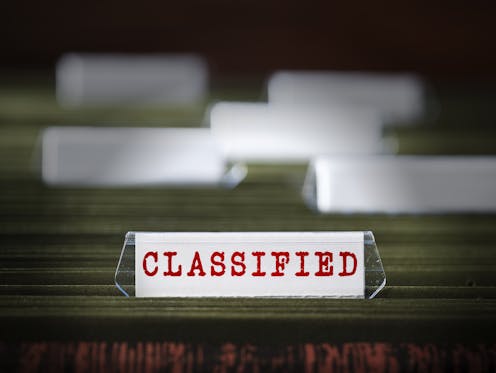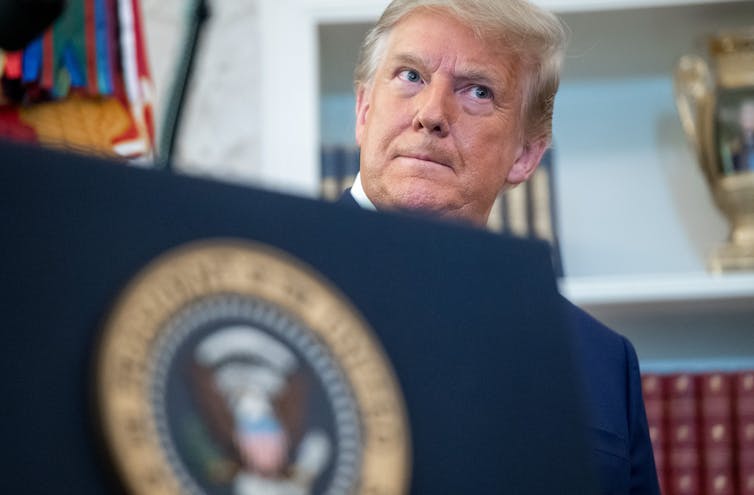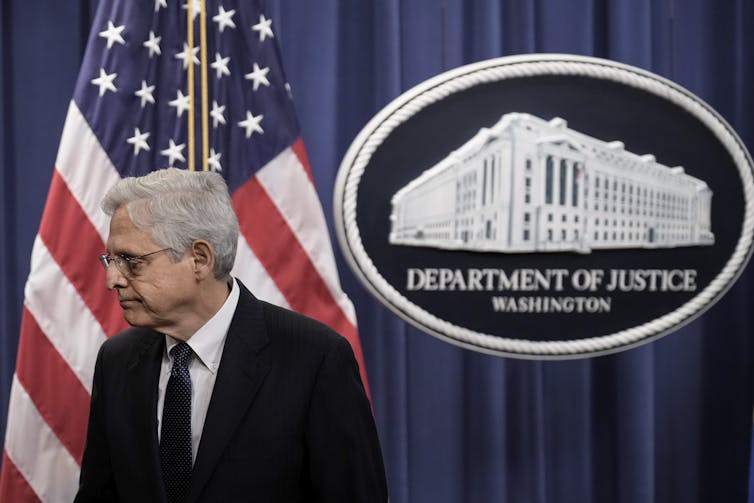DOJ probes Biden document handling – what is classified information, anyway?
What are classified documents? Who gets to see them? What happens if they are released? A former State Department and Department of Defense staffer who had top secret clearance provides the answers.

The U.S. Department of Justice is reviewing the discovery of classified documents found in an office no longer used by President Joe Biden at a think tank in Washington, D.C.
There are superficial similarities linking what was described by Biden lawyers as “a small number” of documents found at Biden’s former office and the hundreds of classified documents kept by former President Donald Trump after he left office. The Trump case has prompted a major Department of Justice investigation into the former president’s potential mishandling of classified materials.
What kind of information is contained in classified documents?
Controlled and restricted
Classified information is the kind of material that the U.S. government or an agency deems sensitive enough to national security that access to it must be controlled and restricted.
There are several degrees of classification. Documents related to nuclear weapons will have different classification levels depending on the sensitivity of the information contained. Documents containing information related to nuclear weapons design or their location would be highly classified. Other information may still be highly classified but deemed not as sensitive. For example, in 2010 President Barack Obama declassified the number of nuclear weapons in the U.S. stockpile.
In general, classified documents must be handled in a way that protects the integrity and confidentiality of the information they contain. This includes securing documents in a safe or other authorized storage container when the documents are not being used by staff. If staff members need to move them from one place to another, they must follow security protocols to do so.
Though classified information can be taken off the premises in the course of official duties, taking classified documents home is prohibited by executive order.

Clearance and classification
Before coming to academia, I worked for many years as an analyst at both the State Department and the Department of Defense.
I held a top secret clearance, frequently worked with classified information and participated in classified meetings. For example, I dealt with information related to weapons of mass destruction and their proliferation.
Handling written classified information is generally straightforward. Documents are marked indicating classification levels.
Tens of thousands of people working for the U.S. government both directly and as contractors have security clearances allowing access to classified information. Many people with security clearances never handle classified material but need to be cleared so they can be present when classified information is discussed.
But not all of classified details describe covert operations or identities of spies. Many are rather mundane. A former colleague of mine who was a retired CIA analyst used to tell his students he would never knowingly, but almost certainly would inadvertently, share a tidbit of classified information in the classroom. It is difficult to remember many “smaller” details that are sensitive.
Dealing with large amounts of classified information over a career increases the possibility of accidentally sharing a small nugget. Sharing classified information knowingly, or revealing information one should know is sensitive, is a different matter.
Here’s how the system of classification works.
Classification levels and content
The U.S. government uses three levels of classification to designate how sensitive certain information is: confidential, secret and top secret.
The lowest level, confidential, designates information whose release could damage U.S. national security. The designation “secret” refers to information whose disclosure could cause “serious” damage to U.S. national security. The designation “top secret” means disclosure of the document could cause “exceptionally grave” damage to national security.
At the top secret level, some information is “compartmented.” That means only certain people who have a top secret security clearance may view it to reduce the risk of any revelations. Just because someone has a clearance at a level that matches a document doesn’t mean the person has a need to access it.
This is often used for the most highly sensitive information, such as that pertaining to sources and methods – that is, how and from where intelligence is collected.
Several other designations indicate restricted access within the top secret and secret designations. The Critical Nuclear Weapon Design Information is a designation given to classified material related to the design and operation of nuclear weapons. This designation would be in addition to a secret or top secret designation, but is not a level of classification. For example, a person with a top secret clearance working on counterinsurgency issues would not have Critical Nuclear Weapon Design Information access.
It is common for written documents to contain information that is classified at different levels, and some information that isn’t even classified. Individual paragraphs are marked to indicate the level of classification. For example, a document’s title might be preceded with the marker “U,” indicating the title and existence of the document are unclassified.
Within a document, paragraphs might carry the markers “S” for secret, “C” for confidential or “TS” for top secret. The highest classification of any portion of the document determines its overall classification. This approach allows for the easy identification and removal of classified portions of a document so that less sensitive sections can be shared in unclassified settings.
A sitting president can access any classified material.
Who decides?
Executive Order 13256, issued by Obama, spells out who specifically may classify information.

Authority to take certain information – say, the existence of a weapons program – and classify it top secret is given only to specific individuals, including the president and vice president and certain agency heads.
Procedures for declassification of materials are complicated. However, the president has ultimate declassification authority and may declassify anything at any time, subject to certain provisions of the Atomic Energy Act.
Deciding what information is classified is subjective. Some things clearly need to be kept secret, like the identity of covert operatives or battle plans. Other issues are not so obvious. Should the mere fact that the secretary of state had a conversation with a counterpart be classified? Different agencies disagree about questions like this all the time.
Mishandling classified information, especially if it is accidental, is usually handled as an administrative matter. However, more serious violations can incur criminal charges and penalties. Federal law (18 U.S. Code § 1924) states that anyone who “knowingly removes such documents or materials without authority and with the intent to retain such documents or materials at an unauthorized location shall be fined under this title or imprisoned for not more than five years, or both.”
This story is an updated version of an article that was originally published on May 16, 2017.
Jeffrey Fields does not work for, consult, own shares in or receive funding from any company or organisation that would benefit from this article, and has disclosed no relevant affiliations beyond their academic appointment.
Read These Next
What’s at stake in Trump’s executive order aiming to curb state-level AI regulation
In the absence of comprehensive federal AI regulation, states have stepped in. The Trump administration,…
Data centers need electricity fast, but utilities need years to build power plants – who should pay?
How many data centers will be built – and how much electricity they’ll need – is uncertain. Being…
Sleep problems and depression can be a vicious cycle, especially during pregnancy − here’s why it’s
Inadequate sleep can have negative downstream effects on everyday cognitive functioning and mental health,…





